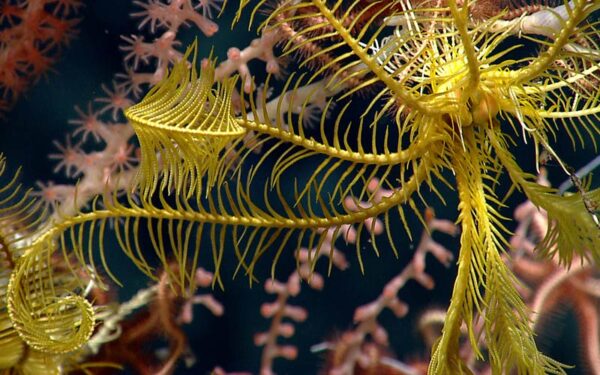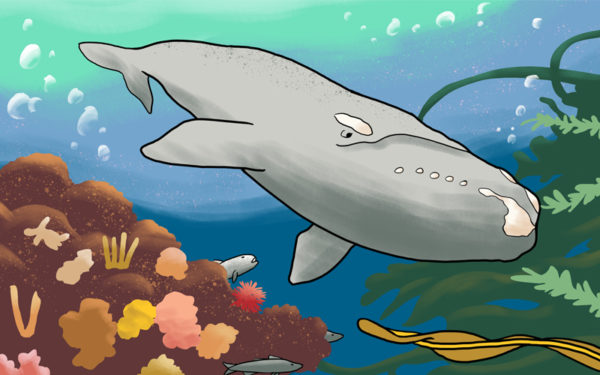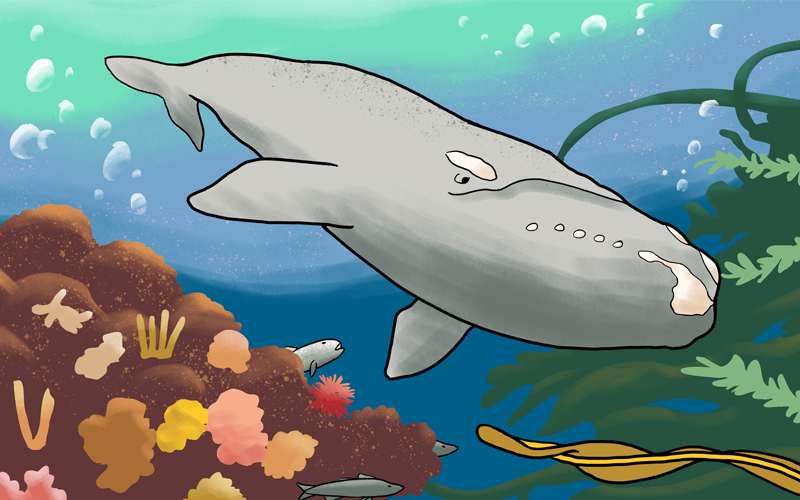
North Atlantic right whales are fascinating, majestic creatures. Get to know some remarkable facts about this critically endangered species. Illustration: Josh Kramer
North Atlantic right whales are one of the most endangered whale species in the world, but the threats facing them are just one side of these fascinating creatures. Right whales have complex social lives, unique facial features, and even a secret method for fighting climate change (hint: it involves their poop!). Watch our video and keep reading to learn more about these gentle giants.
1. North Atlantic Right Whales Can Live Long Lives …
… But they don’t. Right whales can and should live for up to 70 years. But their life expectancy is quickly declining. Scientists identify individual right whales through photographs and compare these images throughout their lives to learn about their lifespan. And according to recent estimates, female right whales are barely making it to middle age.
In fact, these days, not one right whale has been documented living to old age. The biggest threat to adult right whales today is getting struck by boats or entangled in fishing gear.
That’s why we’re calling for more protections in areas where whales congregate. We’re also pushing for wider adoption of “ropeless” fishing gear, which minimizes the chances that a whale will get entangled.
2. Right Whales Have a Thick Layer of Blubber
Right whales’ blubber can be as thick as 12 inches. This dense layer of fat keeps whales well-nourished, protects them from the cold, and provides them with the energy needed to travel hundreds of miles.
Blubber also gives whales buoyancy – it helps them stay afloat with ease.
But blubber doesn’t cover all their body parts. Whales’ flippers and flukes have no blubber. Instead, these body parts help them cool down by releasing excess heat.
3. They Have No Teeth
Instead, they have something called baleen.
Baleen is made of keratin – the same protein that makes up human hair. And though, from afar, the baleen in their mouths looks like an antique hairbrush, only the fringes have actual hairs. The rest of their baleen is strong but flexible. In fact, hunters would refer to baleen as whalebone, and it was a popular material to make springs, toys, and even corsets.
Through their baleen – which works like a sieve – right whales strain ocean water to feed on tiny organisms called copepods.
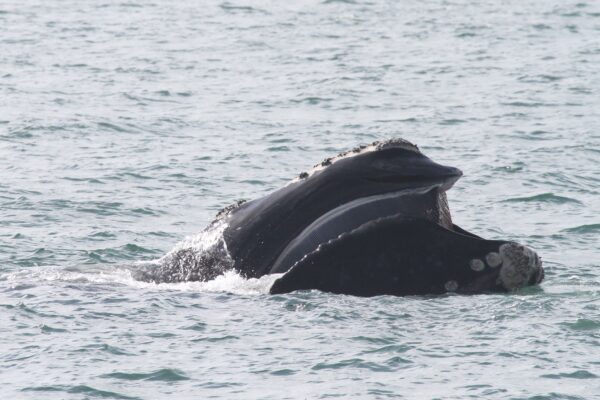
4. Right Whales Eat A Lot
No, really: a lot! It’s not easy living in the cold ocean waters of the Atlantic. To maintain a healthy layer of blubber, North Atlantic right whales must consume more than 2,200 pounds of copepods every day. That’s as much as the weight of a Volkswagen Beetle.
Imagine the work it takes to consume that amount of food in microscopic organisms (one to two millimeters long).
Right whales’ huge appetite is one reason climate change poses a major threat to them. Warming waters are changing where their tiny prey congregates, forcing right whales to change their feeding grounds. This makes it harder for them to feed effectively, giving them less energy for essential tasks like producing calves and healing from injuries.
5. Right Whales Help Fight the Climate Crisis
Here’s that secret way right whales fight climate change: Whales produce lots of plumes (a gassy form of underwater poop). These plumes fertilize the ocean and help feed small organisms called phytoplankton. These organisms, in turn, produce 50% of the world’s oxygen – every other breath we take.
Over their lifetimes, right whales also accumulate tons of carbon in their bodies by munching down on all those copepods, which are rich in carbon. Keeping that carbon out of circulation helps lessen climate change.
We are lucky to have this unsung climate champion roaming our ocean.
6. Right Whales Can Vocalize
North Atlantic right whales can make a variety of sounds, such as whoops, screams, and groans. These vocalizations are not random. Whales use these unique sounds to communicate with each other.
For example, a short ascending “whoop” serves as a contact call to bring other whales together. Male right whales can also make a gunshot-like sound. Scientists suspect that males use this sound to attract females, assert dominance over other males, or a combination of both.
The importance of these aquatic communications is one of the reasons that CLF is pushing for strong noise-dampening procedures for all offshore construction, including offshore wind. Excessive underwater noise could deafen right whales or drive them from prime feeding grounds
7. The Plight of the Right Whale Isn’t New
For centuries, whalers hunted them to produce oil with their blubber – decimating the population. The right whale’s tendency to float when killed, slow pace, and thick blubber made them the “right” whale to kill, giving the species their name.
In 1935, the League of Nations officially ended right whale hunting. And in 1973, right whales appeared on the first “endangered” species list.
But new threats have emerged. Today, right whales still have a long way to go for recovery.
8. Right Whales Are Slow Swimmers
Don’t expect to see right whales at the animal Olympics. Researchers recorded the speed of 109 North Atlantic right whales by observing them in their calving grounds. Most seemed to prefer a calm pace with an average speed of just 1 mile per hour (0.7 knots).
But even at top speed, right whales can only reach 3.4 miles per hour (2.9 knots). Sadly, this makes it difficult for them to dodge threats such as accidental strikes with vessels (boats and ships).
9. They Have Beauty Marks
Right whales have callosities around their heads, a rare feature that gives them their iconic look. These large, rough bumps on their skin are usually covered by “whale lice,” which make them appear white.
Each whale has a unique pattern of callosities that scientists use to identify and track them over the years. Often, whales even get named after their callosities. That’s how Snow Cone, Popcorn, and Cottontail got their names.
To learn more about the naming process, check out this video about how right whales get their names – and how once a year, you might get a chance to suggest a name!
10. Right Whales Like to Hang Out in Groups
North Atlantic right whales enjoy hanging out in groups called SAGs (Surface Active Groups).
Typically, these groups consist of one female and several males competing to mate with her. However, scientists have found that these groups may have other functions besides mating.
Researchers have documented groups with all males, all females, and even all calves. The findings suggest that right whales may also hang out in these groups to play, bond with each other, or simply assert their dominance.
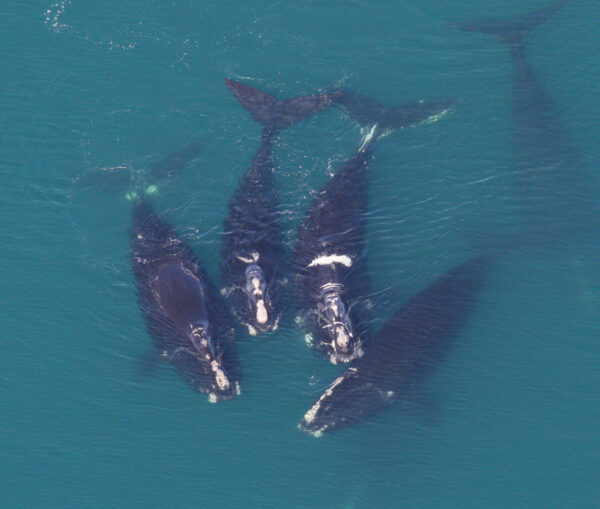
11. Right Whales are “Critically Endangered”
In 2017, 17 right whales were confirmed dead in the U.S. and Canada – an unusually high and heartbreaking number. This is an “unusual mortality event,” a classification that requires the government to provide the whales with more funding and attention.
Even more alarming, scientists believe that for every right whale death we see, we don’t find out about at least two more.
The situation of North Atlantic right whales is so dire that in 2020, the International Union for Conservation of Nature moved right whales from endangered status to “critically endangered.” That’s why CLF and our partners continue to fight to force regulators to create regulations protecting this iconic species’ present and future.
12. There are only around 372 right whales left
Scientists’ latest estimate pegs the population at approximately 372. This is a slight uptick from the species’ low point, but it’s still a devastatingly small number. Before whaling wiped out the population, scientists estimate the population may have numbered up to 21,000.
Even worse, only around 70 of the remaining whales are females at the right age and condition to give birth. The loss of any whale is a huge blow to the species, but mothers and calves are especially precious. Because they tend to migrate together and stay close to the surface, mother and baby pairs are especially vulnerable to getting hit by boats.
13. Right whales can grow to around 50 feet in length and 70 tons
If they make it to adulthood – which fewer and fewer right whales do – these whales can grow to incredible sizes. Even at birth, right whale babies can be up to 15 feet long and weigh a ton.
Unfortunately, stressors like injuries from boats, entanglements in fishing gear, and difficulties finding prey (potentially due to climate change) mean that right whales often aren’t growing as big as they used to. This makes them less likely to have calves.
14. Right whales travel from Florida to the Bay of Fundy
Right whales’ territory spans the length of the Eastern Seaboard. The southeast coast has long been a favored spot for birthing calves. The underwater canyons off Long Island have emerged as a new favorite spot for snacking on copepods, the tiny sea creatures the whales rely on. The Bay of Fundy in Canada is a longstanding historical hotspot.
In between, right whales have been spotted up and down the coasts of eastern states. They’ve even taken the occasional detour across the pond to the shores of Ireland and around the tip of Florida into the Gulf of Mexico. When migrating, they tend to stick close to shore, earning them the nickname “urban whales.”
Unfortunately, this does make them more vulnerable to being hit by boats motoring in and out of ports along the coast.
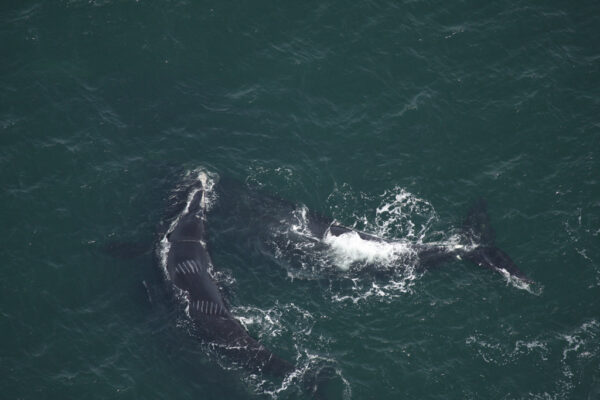
15. North Atlantic right whales have long been important to Tribal Nations and Indigenous communities
There’s little evidence that Native American tribes hunted North Atlantic right whales before European colonization, but they did harvest meat from “drift” carcasses – whales that died and washed ashore. Right whales have held an important place in the culture of many Tribal Nations and Indigenous communities of the northeast for thousands of years. Tribal Nations reserve the right to harvest beached whales to this day.
In January 2024, a young right whale died from entanglement in Maine fishing gear and washed onto the beach of Martha’s Vineyard. When scientists performed a necropsy (autopsy for animals) to gather key information about her short life, they performed it on the land of the Aquinnah Wampanoag Tribe.
Before the necropsy, members of the Aquinnah Wampanoag Tribe gathered to “bless the whale, make offerings, and weep for a being they consider family.” After burying the whale on Tribal land, members of the Tribe plan on eventually using her bones for educational and artistic purposes.
16. Right whales are tricky to track
Monitoring or tagging right whales is a tough task that scientists struggle to accomplish safely. Right whales don’t have dorsal fins (the fins some critters have along their backs), which is often the safest place to tag a marine animal. Using a dart-like tag to puncture a whale’s skin can cause wounds and infections, and lighter, suction-cup-like tags fall off quickly.
Alternatives, like satellite tracking, are being developed. That’s right – at some point, we might be able to track whales from space! Unfortunately, that technology is still in development. Currently, we don’t have a reliable way to track whales in real time. That’s why making the ocean safe for right whales is so important.
These quick facts only scratch the surface of this complex, fascinating species. Marine biologists are still learning more about right whales every year.
The species can still recover, but only if we let it. Last year, approximately 20 right whales were born, and at least nine whales died or were seriously injured. For it to have any chance of recovery, the species needs far more births and far fewer deaths and injuries.
These whales have roamed the ocean for millions of years. We’ve come close to wiping them out in just a few hundred years. These playful, intriguing animals deserve better. Please join us in calling for a safer ocean for right whales.


